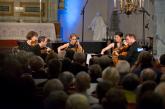 Vårt Land reports on the first Rosendal Festival and its new acoustics
Vårt Land reports on the first Rosendal Festival and its new acoustics
“The beautiful village by the Hardanger Fjord has its roots in the Barony which dates from 1665. Leif Ove Andsnes has created a music programme which fits the setting – and literally created a new sound for the Barony.
“The Rosendal Chamber Music Festival stands in a long line of similar musical gatherings across the country. The numbers grow every year and what makes that joyful is that they seem to cover a still unsaturated demand. The Rosendal Festival sold all of its tickets in a just a few days over the winter. The recipe is simple: core chamber music programming, no pandering to appeal and with bold touches of contemporary music.
“Now the Barony has converted the barn into a concert hall, an essential space with 460 seats. The place has a long tradition of intimate concerts in the old manor house. The small concert venues are also used during the festival, creating an intimate Schubertiade.
“What is brand new at this festival is that the sound of the new “Riddersalen” in the old barn is digitized. That’s almost like swearing in church for chamber musicians. But the elongated wooden structure would have been heavy and difficult to fill purely acoustically. How it might have worked naturally, we never hear, but the digital processing Andsnes envisaged before the festival proved to meet expectations – and of course, was the big talk amongst musicians and audience alike.
“What at first surprised a little was that even the smaller groupings from three to four musicians were lifted out and opened up in a whole new way. In a slightly bad seat, far behind and to the side, you heard a sound you simply would not normally have expected … But soon you realized that it was actually processed and that a proper soundstage was taken down to even a bad seat in the hall – using advanced digital technology. Wherever you sat, you were introduced to an idealized sound impression, and sometimes cognitively confused because what you heard did not match what you saw … The exciting thing was that you were invited into a little magical and intimate experience, no matter where you sat in the hall …
The topic was Schubert 1828 and the huge amount of great music he left behind, just in the last months of his life. It was a brave programming where all the concerts had at least one work from 1828. A weekend course in Schubert, with a focus that allowed the audience to return home with a lot of new insights into the composer’s wonderful world …
Highlights
Matthias Goerne’s passionate understanding and execution of Schwanengesang at the opening concert was a strong testimony of both agony and frantic life-affirming.
Also the newer music, especially contemporary music, was oriented towards Schubert. John Harbison’s hallucinations of the composer’s death was another highlight. Densely and intensely performed by Guro Kleven Hagen, Frida Fredrikke Waaler Wærvågen, Eivind Holtsmark Ringstad and Andsnes himself. The young Norwegian profile was evident throughout the festival … Another highlight was the String Quintet, performed in Kvinnherad’s medieval church by the Brentano Quartet together with star cellist Sol Gabetta. One of the most beautiful works Schubert left behind, and played with a shocking insight into the tension between death’s throes and a longing for bright spots in existence.”